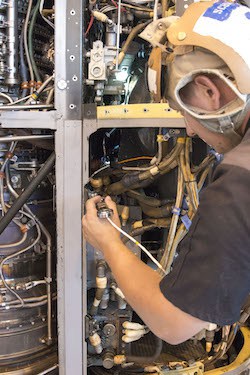The US Naval Air Systems Command (NAVAIR) has successfully completed the first flight demonstration of a flight critical aircraft component built using additive manufacturing.
The MV-22B Osprey completed a test flight fitted with a titanium, 3D printed link and fitting assembly for the engine nacelle. According to NAVAIR, the assembly is one of four that secure a V-22’s engine nacelle to the primary wing structure and will remain on the aircraft for continued evaluation.

“The flight went great. I never would have known that we had anything different on-board,” said MV-22 Project Officer Maj. Travis Stephenson, who piloted the flight.
The metal link and fitting assembly for the flight were printed at Naval Air Warfare Center Aircraft Division in Lakehurst, New Jersey. Prior to the flight, multiple V-22 components built by Lakehurst and Penn State Applied Research Laboratory were tested at Patuxent River for validation.
“In the last 18 months, we’ve started to crack the code on using AM safely,” said Liz McMichael, AM Integrated Product Team lead. “We’ll be working with V-22 to go from this first flight demonstration to a formal configuration change to use these parts on any V-22 aircraft.”
US Naval Aviation has employed additive manufacturing as a prototyping tool since the early 1990s and has recently begun the process of printing non-flight critical parts and tools. The flight demonstration was the first US Navy aircraft to fly with an AM part considered essential to maintaining safe flight.
Navy officials are said to envision a future where all parts can be made on-demand globally by fleet maintainers and operators, plus industry partners. In practise, digital data will be stocked, removing the need to order, stock or ship parts.
Including the V-22 link and fitting assembly, McMichael and her team have identified six additional safety-critical parts they plan to build and test over the next year for three US Marine Corps rotorcraft aircraft — the V-22, H-1 and CH-53K. Three of the parts will be made out of titanium, while the other three will be stainless steel.
Despite the successful test flight, NAVAIR officials said that additional work needs to be done before deployed aircraft can fly in theatre with 3D printed, safety-critical parts.
“Our AM team has done some incredible work in a relatively short period of time - both internally through its production of aircraft components to be used in flight testing and externally through its liaison with industry and other government organizations,” said Vice Admiral Paul A Grosklags, NAVAIR commander. “Although the flight…is a great step forward, we are not trying to ‘lead’ industry in our AM efforts, but it is absolutely critical that we understand what it takes to successfully manufacture and qualify AM parts for flight in naval aircraft, which we expect will largely be manufactured by our industry partners. Where I believe we can ‘lead’ industry is in the development of the AM "digital thread," from initial design tools all the way to the flight line -- securely maintained and managed through the life of an aircraft program.”





Project to investigate hybrid approach to titanium manufacturing
Sadly they will not be ordering any more presses from Wilkins & Mitchell http://www.historywebsite.co.uk/articles/Darlaston/WM.htm